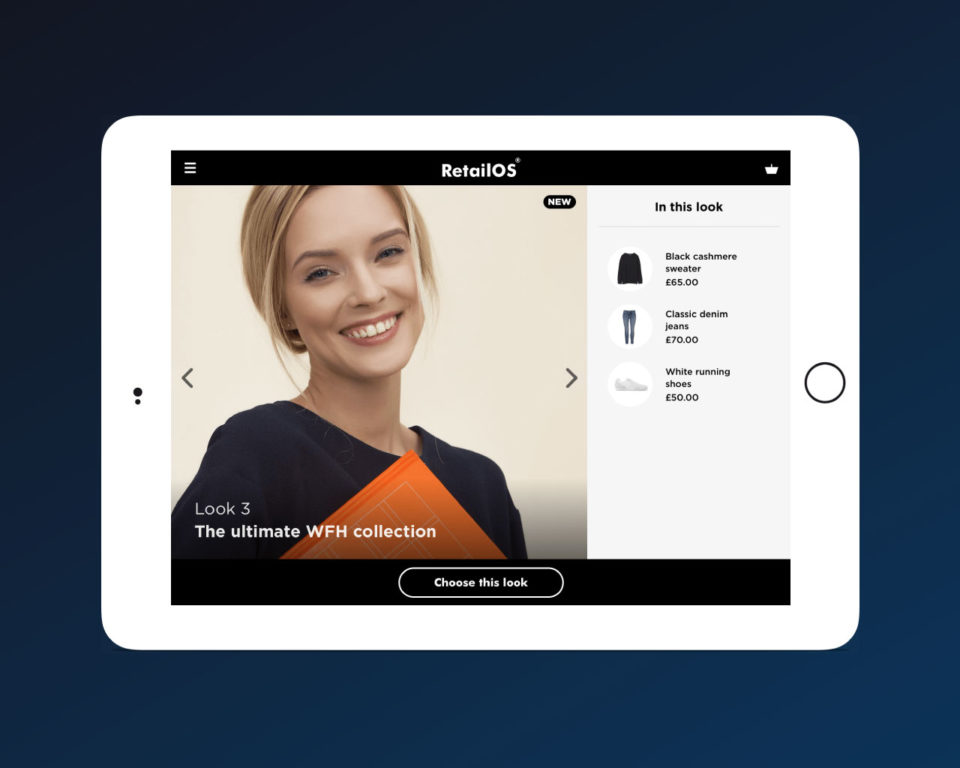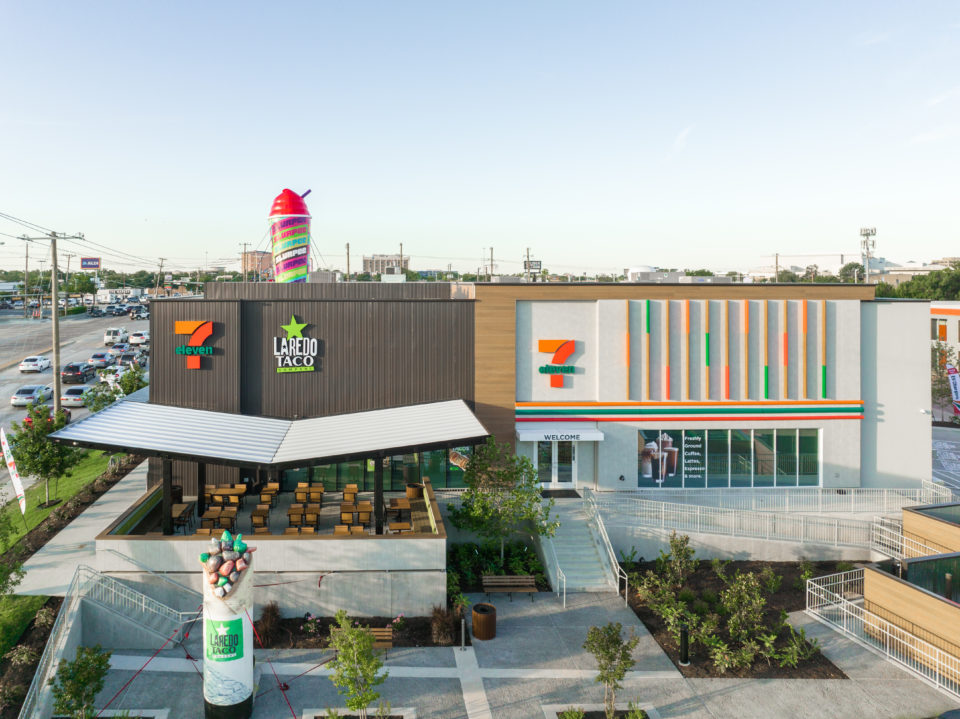Connecting the dots: DevicePilot talk managing the IoT
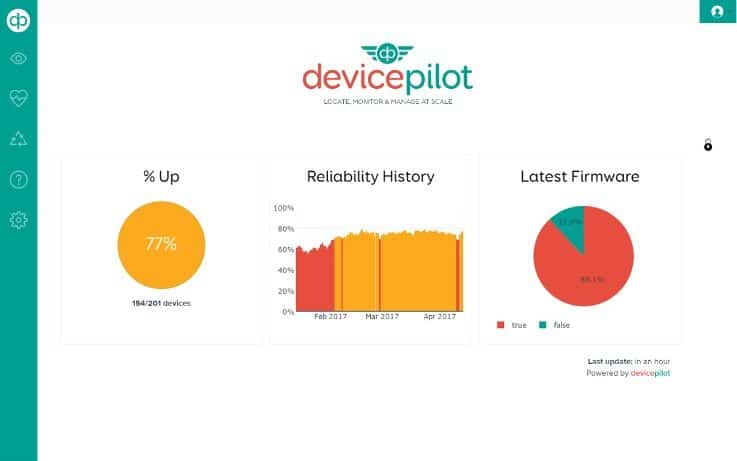
We’re all aware that the world is becoming more connected. Now most of us have a smartphone in our pocket, the Internet of Things (IoT) seems set to increasingly be part of the future picture. But if everything is connected, how do you manage it all?
DevicePilot helps companies take control of their connected devices. Regardless of type or manufacturer, DevicePilot gives complete operational management of them all and helps automate processes for a better customer experience. The company is headed up by CEO Pilgrim Beart, a veteran in the IoT business and co-founder of the connected homes platform AlertMe – which powers smart heating system Hive and is now owned by British Gas.
He tells us about the challenges that led to DevicePilot’s inception, the IoT movement and the challenge of disintermediation as all parties race to own the customer relationship:
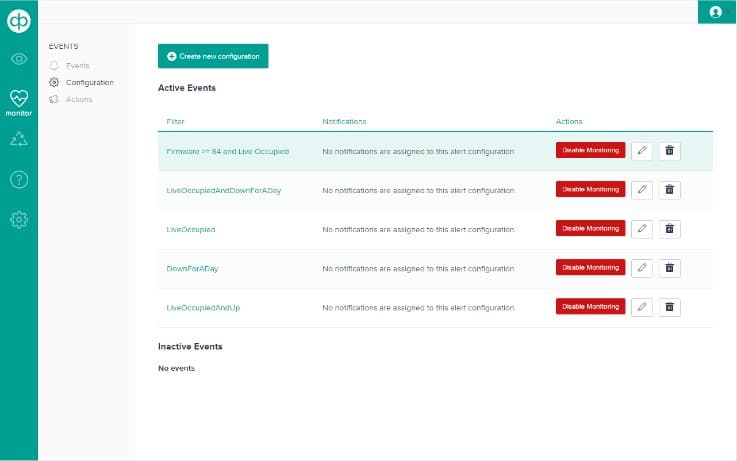
Can you explain what DevicePilot does?
It started with AlertMe and Hive. In the first couple of years we built the devices, the platform and the application, got it into the hands of early users and got it to the point where it more or less worked most of the time. As we started to deploy in any kind of numbers, we discovered we were losing track of what was working and what wasn’t, which customers were happy and which weren’t.
Early adopters will tolerate things that don’t always work perfectly but as you get into the mainstream you have to deliver an excellent experience, first time, every time. The only way you know how to do that is to actually measure it. So, we found we were missing a big piece around operational management. It was quite an expensive lesson and it really showed us that operational management is a barrier to scaling, because to scale well you have to get your processes automated so that you can deliver quality at scale without having to have lots of people. So that was the motivation for DevicePilot.
When we started the company we asked if the AlertMe story was unusual in some way or if that was actually the typical experience? As we talked to more and more companies in more and more different markets, we found that people in the early days of IoT were just focused on getting their product built.
But the ones who’d actually got to any kind of scale, deploying more than a few hundred devices, absolutely understood what we were talking about and had the same horror stories to tell about how expensive and painful it was dig themselves out of this firefighting process that you get into if you try and scale when you’ve still got the same manual processes that served you well in trials. That gave us the confidence that there was a universal problem across all companies deploying connected devices around operational management.
First and foremost, DevicePilot is a pure cloud business solution for business people. Our customers are companies who are deploying products like AlertMe and then eventually have customers that they are serving. It’s our job to give them a tool to help them serve their customers better by having a big picture about what’s going on with their devices.
DevicePilot has four parts – the first is the dashboard, which gives you the key metrics about your devices’ state and whether they’re getting better or worse. Second is asset management – what have you deployed? Where is it? What software is it running? Who has got it? Third is monitoring; if something’s broken you want to know immediately and you want to understand why. The final piece is process automation which is closing the loop.
There are a lot of processes around devices like onboarding, security, software upgrades, battery replacement etc. If you try to do these processes manually, they won’t get done, they’ll get done wrong, they’ll get done slowly, there are a lot of problems. DevicePilot is a way of automating that. You can specify processes you want to happen , which might include human delivery, but DevicePilot manages that process letting you audit, enforce and automate any processes around your device. And you can do it for a hundred devices and you can do it for a hundred million.
That’s particularly true when you’ve got multiple types of devices. You might be buying some of your shelf-edge labels from one company and some from another but you still want to have a coherent single view about everything. DevicePilot is a good place to do that because it’s agnostic to the manufacturers.
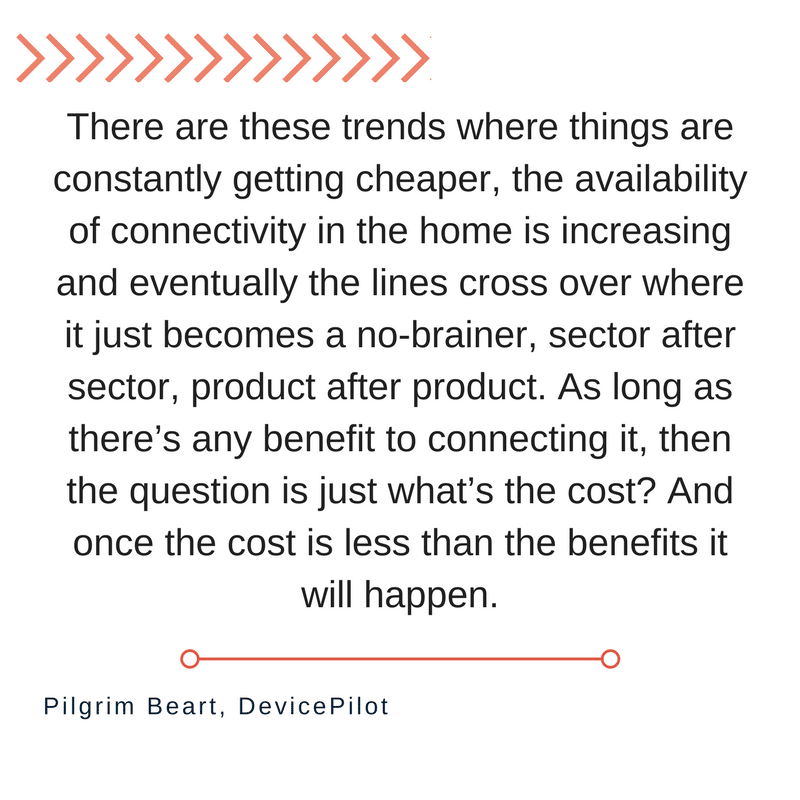
Which elements of your service does retail respond to best?
Every retailer is customer oriented. Retailers probably have the least trouble putting themselves in their customer’s shoes. Much more than most companies, there is a very tight feedback loop on whether customers are happy. The thing we focus on is customer experience. DevicePilot is a component in an overall connected product offering, be that a piece of retail technology, a B2B application or a consumer facing solution like AlertMe.
What’s interesting about all of these is that they’re becoming more like services. In the olden days everything was sold as a product and maintenance and support would be a separate thing. Now, increasingly things are sold as a service. Whether it is your Hive heating system or your shelf-edge labelling or whatever you probably buy it as a service more than as a product. Therefore the vendor, the original manufacturer or the entity that’s selling this thing to you, is responsible for the complete experience of that thing, not just on making sure that you’ve got the hardware and the hardware is not broken.
The figures around British Gas and Hive are really impressive – can you explain these in more detail?
It’s such an interesting example of a company changing. It’s a completely shift in attitude from an extremely arm’s length relationship where a customer might get a bill every few months, to one where the customer has your product in their pocket on their smartphone and they use it several times a day. It is just a completely different type of experience. Things like Hive’s net promoter score are pretty jaw-dropping but the question is what can you do with that? Obviously there are various products and services that you can sell on the back of it, but I suspect its biggest value is the brand value that it gives you.
It’s like the iPhone gives Apple an awful lot of power. An iPhone not only makes Apple a lot of money, but it also gives them permission to occupy parts of your life in our increasingly busy world. The more value anyone can deliver in that, the better the relationship they’ve got with you and potentially the more money they can make out of you. It’s quite strange in a way that a utility company like British Gas can potentially be playing that game on a level playing field with Google and Apple and Amazon but they are.
Those big internet players could potentially be a threat to companies like British Gas because they can disintermediate them. If you get a thermostat from Google, you now have a relationship with Google and that can make the utility a commodity. It completely disintermediates the retail relationship and it wouldn’t be hard to imagine Google then offering you an energy tariff based on what it knows about your energy consumption. And then British Gas is completely out of the loop. That same dynamic is happening in retail more generally.
The one thing about technology is that nothing stays the same. It evolves really rapidly and you’ve got to play the game, and you’ve got to keep running on the treadmill and running faster than your competition.
One of our customers is Lowe’s in the US. They were AlertMe’s second biggest customer and their smart home platform Iris was AlertMe. The reason they did that was twofold. The first was that they noticed that more and more products that they were selling were connected, whether they were burglar alarms or solar panels or whatever. The issue with that is it meant that the product vendor ran the service for that product and therefore the product vendor had the relationship with the end customer not Lowe’s. This means you’re at risk of being disintermediated by your vendors.
The second problem was from a customer experience point of view, none of these things worked with each other – they all had different standards, different gateways, different apps. Before long the customer has five gateways in their home and five different apps on their phone and it’s just not a good customer experience. Even before the AlertMe relationship, Lowe’s set up a service called My Lowe’s, which is a cradle-to-grave customer engagement strategy beginning with the web. If you are thinking of refurbishing your kitchen for example, you could use My Lowe’s to help you plan everything. The clever thing is that it is the beginning of a relationship. If a few years later when you think ‘I want new surrounds on my light switches’, you can go to My Lowe’s, which knows what you installed in the first place and what else will fit. There was a negative reason and a positive reason for doing it – the negative reason was to avoid being disintermediated and the positive reason was to give the customer a unified experience and to earn a place in their life.
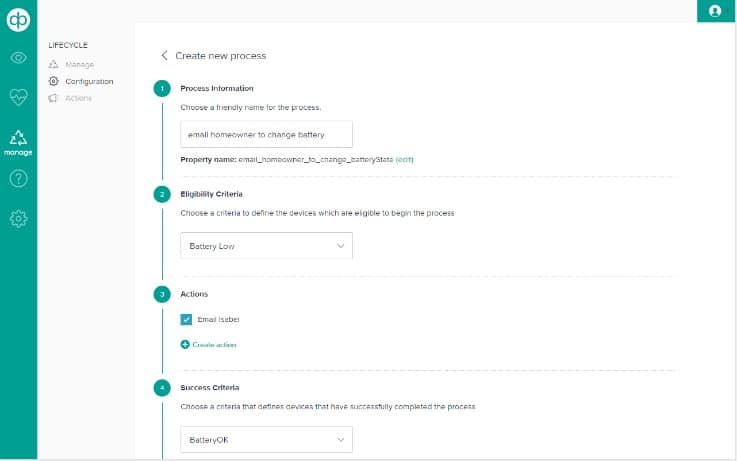
Do you see every product and device that somebody might own eventually being connected?
I think they will all be connected. It’d already happening. We’ve already gone through the phase where everything has a processor in it, even something like a toothbrush. If you just want your toothbrush to time how long you are brushing your teeth for, you put a processor in it because that’s the cheapest way. It used to be a resistor, capacitor and transistor. Now, it’s cheaper to just put a processor in it because they are so small and so cheap. So you’re halfway to the IoT already, the bit you need to really enable it is the connectivity. There have been various obstacles to that which are gradually getting knocked down.
So, there are these trends where things are constantly getting cheaper, the availability of connectivity in the home is increasing and eventually the lines cross over where it just becomes a no-brainer, sector after sector, product after product. As long as there’s any benefit to connecting it, then the question is just what’s the cost? And once the cost is less than the benefits it will happen. The cost is constantly falling. In fact, if anything the benefit is rising because as some things get connected there are more reasons to connect other things because you might be able to control them all from one app or they might be able to interact together in some useful way.
If you think about the things in your home, a lot of them might care about whether your home is occupied or you. You might want your washing machine to only run when you’re not there because it’s noisy or you might want your heating to turn down when you’re not there to save money or you might want your burglar alarm to turn on when there’s no one at home. Now, how do you tell if the house is occupied? It’s actually quite hard. There is no one sensor that accurately detects whether your house is occupied. Motion sensors aren’t perfect. You can detect devices on the network but people leave their smartphones behind. You can detect whether appliances are being used, but they sometimes run when people aren’t at home. So, in fact, there is no sensor that is 100%.
But using sensor fusion to actually merge information from multiple devices together, which services that AlertMe can do, and also spotting people’s patterns over time, you can build up a very accurate picture of whether the home is occupied right now and also whether it’s going to be occupied in ten minutes or ten hours. Armed with that information you can then modify all sorts of things in the home to optimise experience for the customer. No one device on its own has really got enough information to do that job. But together they can.
You’re not going to build all that technology into a washing machine, but if a washing machine can just get a signal saying that now is a good time to run then it can do that. It doesn’t have to understand electricity tariffs and solar panels and occupancy and all those things. The simplest case I can think of is the time. How many clocks do you have in your home? As we get more and more of these gadgets, potentially they can create more and more hassle in our lives because we have to do things like setting the time.
It’s really important that the intelligence grow as well, so that we don’t have that load. They need to take care of themselves. And if they can’t take care of themselves, something needs to take care of them and that’s very much what DevicePilot is all about. One of the reasons that managing IoT is harder than managing some other things in our lives is because a lot of these devices aren’t actually that clever. So you need to manage them. What you don’t want to do is leave the user with the management burden.
When and what do you think that the tipping point for this will be?
I think the cost benefit will drive the tipping point. The first application has to bear all the cost. So that acts as an inhibition for quite a long time until you can justify connecting something to that first application. Once you’ve done that, all the other applications can then ride off the back of it and suddenly, everything is connected. You’ve done the hard bit.
I think the tipping point varies depending from household to household, from application to application. In terms of the very big picture, do you call it the tipping point where one percent of people have it or ten percent or ninety percent? We’ve already hit the tipping point in terms of smartphones and broadband. I think with things like Hive you could argue it’s not there yet as although it’s very inclusive, less than five percent of the population has connected heating systems.
It’s not at that point where it’s the norm but bit by bit that will happen, because it’s increasingly becoming part of the replacement cycle. It’s becoming hard to buy a heating system that isn’t connected, wherever you buy it from, and the same is true for cars. More than a quarter of all new cars are connected, it will soon be half and three quarters and so on. When things become connected by default, then you’re just in for the replacement cycle. Obviously the replacement cycle for some white goods can be quite long, but for most consumer goods it’s much shorter.
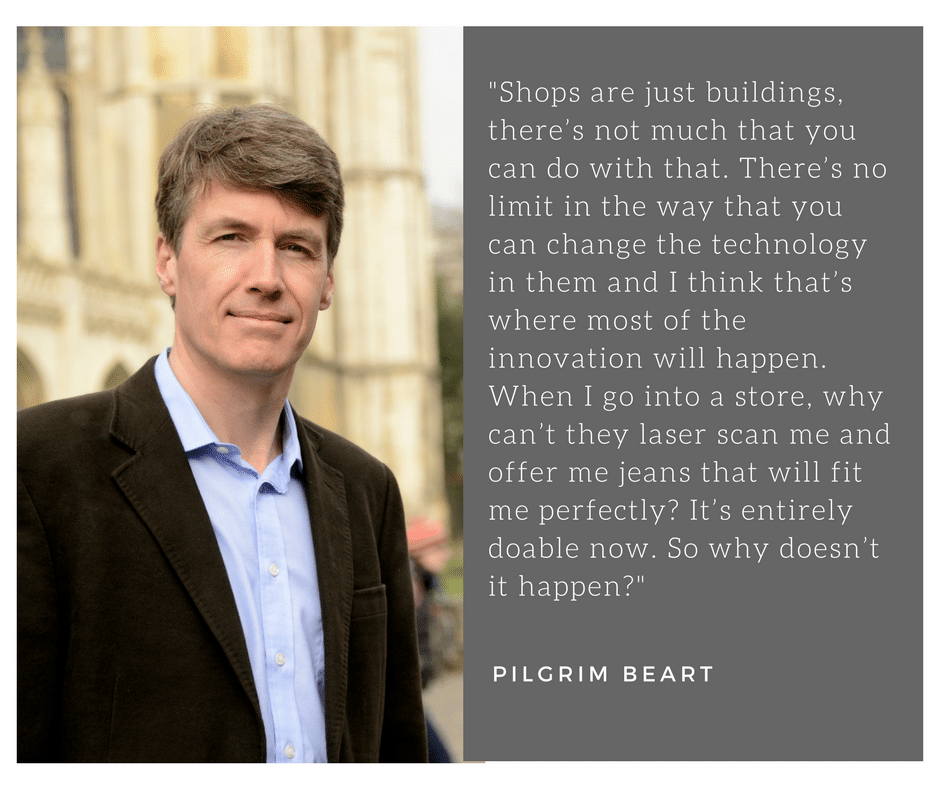
Can you tell us a bit more about the applications for retailers?
When you talk B2C it’s all about customer experience and things that are quite soft because consumers do not think in terms of return on investment or service level agreements or key performance indicators. But B2B absolutely does. In that kind of world it’s a much more functional thing.
If a company is selling a connected product like shelf-edge labels, RFID, stock management or building management for heat or security, then obviously there’s some kind of reason for doing that, some kind of internal investment calculation and some kind of assumption about the performance of that product.
One thing that has been quite interesting over the last year for me is that there’s actually a sort of multisided model of Device Pilot. Our initial focus is on the vendors who are making and delivering these kinds of connected offerings to give them the tools to do the job. But actually, we found that increasingly, the people we talked to and work with want a customer facing view of the same thing. They want to show their customers that they are delivering the sort of service that they said they would. And sometimes those customers may need to take action to help themselves if something is not working like replacing batteries. By giving them a view of their devices, in DevicePilot, then they can be that. I think potentially, we have a role of almost being an honest broker in the relationship between the vendor and the customers.
Our chairman and a couple of our executive team come from the telco world where they built similar systems to DevicePilot but in the telco world. Imagine the millions of pieces of metadata coming out of a cell tower every day, all the calls that it’s accepted and calls that it’s dropped, how do you boil that down into some key metrics to show you that cell tower is actually working as specified or not?
The interesting thing was they started off doing that as a service to the vendors but they ended up actually becoming an independent third party. So, when there was a debate between the vendor and the customer about whether the tower was actually working, everyone would look to this tool see what it said because that was said to be the truth. You got to trust something. And so, I think that’s quite an interesting role in the ecosystem that we hadn’t really understood initially but increasingly see for us.
Are there particular clients and vendors that you’re working with at the moment?
We spent last year in beta testing and were ready for commercial engagement at the end of the year. We are now signing up a sales pipeline with the usual wedge of smaller faster customers and bigger slow ones. We’re really focused on three markets which are consumer, which could include retail, energy and smart city/logistics. These seem to be the three verticals that have got the most traction.
The small, agile young companies who are our customers are companies like Doordeck who let you open doors in commercial buildings without keys – they basically turn your phone into a key, which is quite cool. In some connected environments if something doesn’t work occasionally it doesn’t really matter as no one notices. But if a door lock doesn’t work everyone notices, so they have a particularly acute need to really make sure that it’s working and to know quickly if it’s not.
Another one would be Switchee. They have a thermostat offering that’s a bit like Hive but it’s focused on social housing. Their customer is the housing association that has tens of thousands of tenants and they’re interested, not just in the tenant’s welfare, that they’re not too cold and so on, but also humidity. Damp can obviously cause health issues, but also they’re worried about the fabric of the property. There are different kinds of damp, such as rising damp and then damp from people drying clothes. Switchee thermostats can differentiate between those and help housing associations to manage their tenants and their properties. Our role is to help Switchee to keep on top of and manage their operations.
We also have clients in the energy sector who are doing things like demand response in commercial and industrial applications to adjust how much they consume in response to the needs of the grid. That’s quite a big thing as we move more towards renewables as we need loads to adapt to the available supply.
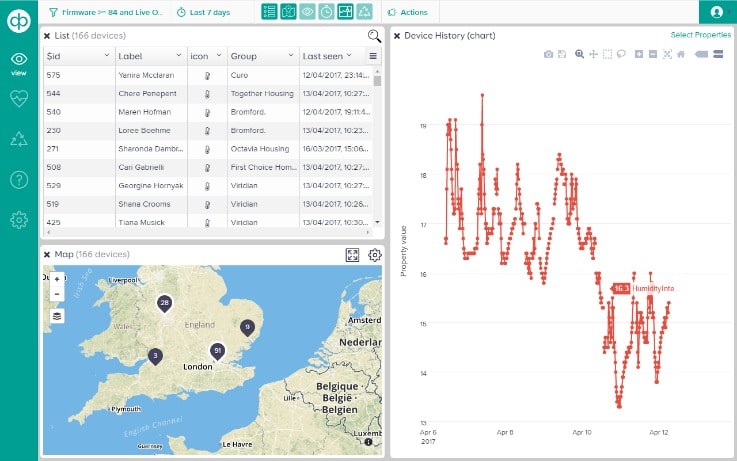
What are the human benefits of IoT?
Where we started with AlertMe was peace of mind. Security was actually the first application for the smart home that we developed, before we got into energy. The system would let you know if your house was being broken into or was burning down. The fact that you knew you would be the first to know let you relax because you know that’s it’s not happening.
I think that same peace of mind extends to other applications as well. Most of the IoT applications have a win-win benefit, so they have a benefit to the user but they also have a benefit to the wider society. With energy if you can save money then that’s great, but reducing usage also helps climate change. Another killer application for smart homes is telecare, which is keeping a friendly eye on people as they get older. There are massive benefits to being able to keep people in their own homes as it’s better for their health and wellbeing, but it’s also better for society as it is much cheaper.
With a relatively small amount of technology, it’s possible to keep a friendly eye on somebody and know you’re going to quickly detect if they have a fall or if the house isn’t warm enough or whatever. That allows you to do a much better job of caring for them even though you can’t be there 24-7. I’m not saying technology is a complete panacea but I think there is definitely a role there in doing a better job of caring. There is a peace of mind.
There is a Jekyll and Hyde aspect to IoT. Initially there is that tendency for things to get more complicated. But actually, that can’t go on because our attention and our knowledge is finite. Ultimately, in a world where we have more gadgets than we know what to do with, the big value becomes simplicity. I think to some extent you could say that’s Apple’s thing – you don’t give people everything, you actually work really hard to simplify the product, eliminating features, reducing choices but keeping the experience simple. That’s worth a lot to people.
It feels to me that that’s the flow that we have to go through with IoT. It’s amazing to me at AlertMe and then Hive how we came up with a product that we thought was a good product and then we realised that it was hopelessly complicated and we made it simpler. Then we realised that it was hopelessly complicated and we made it simpler and we kept on doing that. There is still room for it to improve. I think that the best user interface is no user interface. You want products to be so clever they just know what to do all the time every time without having to engage with them at all.
When that works, people really stop thinking about their technology, they stop thinking about the actual gadget, they just think about their home and interacting with their home. And you can see that now with things like Alexa or other services – the fact that you can now engage with your home by talking to it or just clicking on an app. Or you don’t even have to do that because it just know what you want and it sees you come home and it knows what temperature you like and what you want the lights to do. It really gets that right and that is like magic. The technology disappears completely into the background because it’s not about technology at the end of the day, it’s about you enjoying your life.
Does this apply in the retail environment as well?
Shopping can be an unpleasant experience. You have to stand in a hot shop trying on things to find that they don’t fit. It could be a delightful experience. I’d like to walk into a shop and be offered some choices, be offered only things that fit me and only things that I want, and only things that I can eat from a dietary point of view. We’re not far off from being able to offer that to people.
Metail are a company that let you create an avatar of your body which lets you shop online. It’s only available for women at the moment but it’s coming for men soon. It means you can see how things will look as the clothes are effectively draped over your body. That gives you much more confidence that you’re buying something that will work for you. That benefits everyone because it means the customer gets more of the right product first time and the retailer doesn’t have a lot of returns.
That kind of thing would drive amazing brand loyalty because the retailers know more about the customers – what stuff they like and so on. Like Hive it earns them a place in their lives. I feel there is a lot of room to improve the retail experience. It’s coming, one way or another. The really big question is how much of it will be online and how much of it will be treading the boards in the retail stores.
Any other companies that you think are cutting edge in this respect?
It’s really interesting how connected cars have become an iPhone on wheels and the opportunity to give people an experience in that captive environment. Also, the way that players like Tesla are just completely rewriting the rules, not just because their cars are electric but because the cars update themselves every night and they get better all the time. They go faster all the time. That’s making all of the incumbent vendors extremely scared.
If you look at the self driving computers that are now going into retail cars today, they are astonishingly powerful and you can see that more and more of the percentage spend on a car is going to go into that. The drive chain has become about as cheap as it can be, so innovation happens in high technology. I think that’s going to be the same for everything in shops as well. Shops are just buildings, there’s not much that you can do with that. There’s no limit in the way that you can change the technology in them and I think that’s where most of the innovation will happen. When I go into a store, why can’t they laser scan me and offer me jeans that will fit me perfectly? It’s entirely doable now. So why doesn’t it happen?
Check out our guide to how the IoT is changing the future of retail, and get more IoT facts in our factfile.
Want to quickly and easily connect with the players kick-starting trends and inventing the future of retail? Find out how you can transform your team’s thinking using Insider Trends’ little black book here.
Images courtesy of DevicePilot

